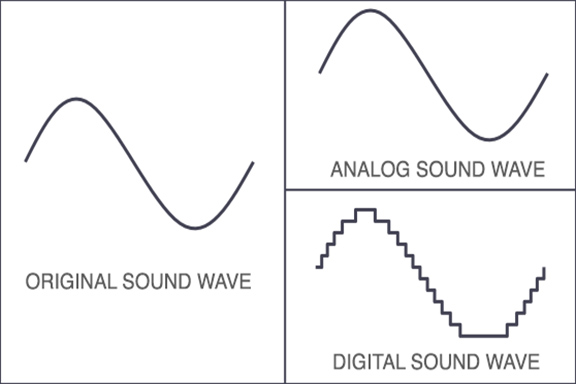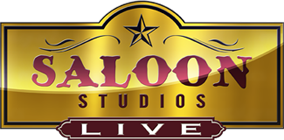We, at Saloon Studios Live and Saloon Studios Live Productions, are here to help.
PART TWO
What is the difference between Analog and Digital?
When recording, the format is a 2-way street… you have your Analog Lane and you have your Digital Lane. Most will tell you analog has a “warmth” incomparable to digital. The simple explanation of “warm” is used as a roundabout and/or all-encompassing term. In actuality – though it does sound “creamier” (another term) it goes much deeper than that.
ANOLOG refers to an audio recording using a “replication method” capturing the original sound waves. Examples: Vinyl records, cassette tapes, and reel-to-reel.
DIGITAL refers to an audio recording using a “sample” method. The original sound is captured at a specified rate. Examples: CDs, MP3s, and DAT.

If we look at the diagram, we can see the analog sound wave replicates the original sound wave, while the digital sound wave replicates the “sampled sections” of the original sound wave. The potential fidelity of the analog recording depends on sensitivity – factoring in the equipment, and mediums used to record and playback your recording. Digital audio fidelity depends on the rate at which your recording equipment samples the original sound wave – over a specified increment of time.
With all we have in today’s technology within the recording industry, digital audio still cannot create exact replications of an original sound wave. “Uncompressed” and “Lossless” are two of many hype-words that are used to mislead us into believing what the Digital Audio Companies want us to buy into. The truth is, all Digital Audio features some “compression” and “loss” of the original signal. Never-the-less, even a highly-trained ear, such as Recording Expert George Martin, may NOT be able to tell the difference between an analog audio signal and a high-quality digital signal.
Here is an easy way to think of the difference: Think of a strobe light as Digital and a standard light bulb as Analog. The strobe can actually flash so quickly that it is almost unnoticeable when it is on the off mode.
Justifiably so, today’s digital audio players have become the portable audio device of choice, offering many benefits. Not long ago, it would have been unheard of for someone to carry around thousands of songs ready to play in an instant. Unlike the days when your Record Albums were stacked, side-by-side, neatly in alphabetical order on the shelves that held them… today your entire music collection can be carried around in your pocket. But…are we jeopardizing the cost of fidelity? Sure, the sound can be “suffice” for the average listener who is ear-budded into their mobile device. Even still, in the hard light of day, “the Purist” might argue the facts and never be satisfied with the digital audio replication of today’s sound environment.
You may ask yourself, “Why do I need to know these things when I am probably going to record at a digital recording studio anyway?” Here’s a perfectly good reason: I, myself, have many synths and workstations I use for recording… but I always midi up my vintage/analog Korg-8000 for a “warm” pad-sound which my digital keyboards can’t come close to.
(Stay tuned for Part-3 next week)
For more information about recording at Saloon Studios Live Productions, contact our chief engineer, John Littlewood.
